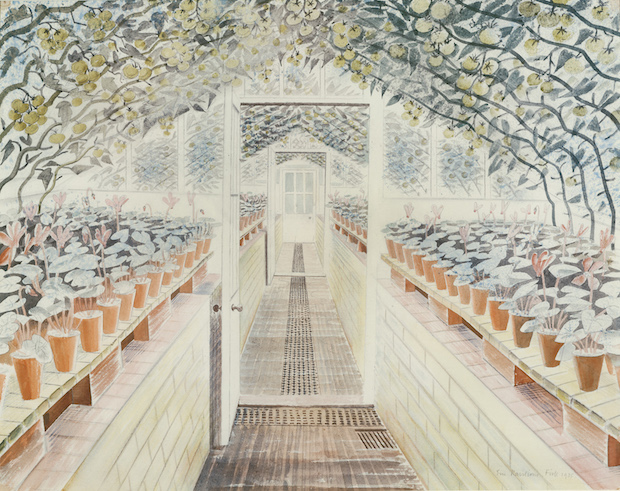A new exhibition focusing of the watercolours of artist and designer Eric Ravilious at Dulwich Picture Gallery positions the artist as one of the greats of twentieth century British art.
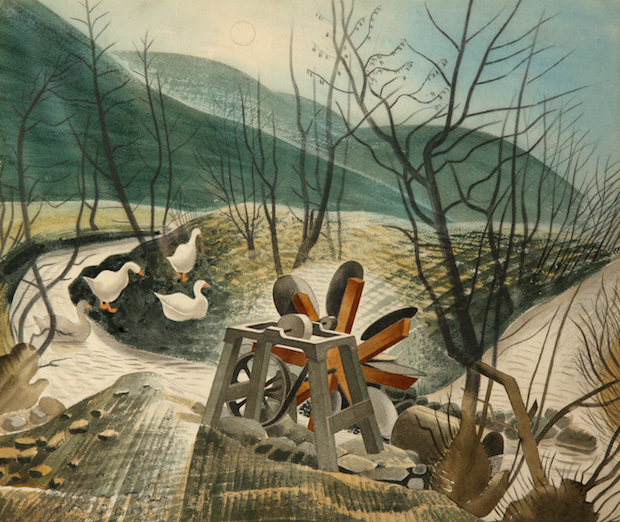
Ravilious’ work has been described in various ways, from cold to comforting, but one consistency in writers' descriptions of him seems to be the word ‘poet’. Ravilious presents a world to us which in many ways is quite ordinary, but bestows this view with nuance, insight and wonder. Like a poem, a Ravilious painting imparts its gifts slowly and only after multiple readings. With his reputation steadily re-growing over the last decade or so, Ravilious’ watercolours have got a thoroughly deserved exhibition to themselves at Dulwich Picture Gallery. He may have been trained in the Design School at the Royal College of Art but alongside tutors like Paul Nash, and friends such as Henry Moore and John Piper, Ravilious was part of a generation which could apply its talents equally well to commissioned projects as their own personal vision.
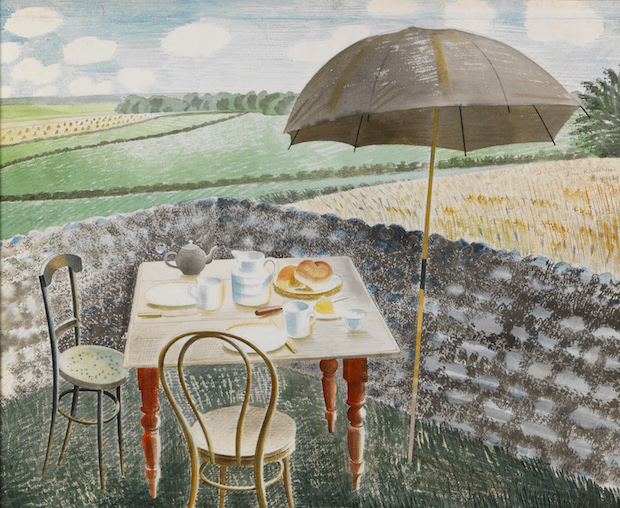
Ravilious’ art, however, stayed rooted in design and has an undeniably graphic quality. Unlike Piper who championed abstract art after leaving the Royal College, Ravilious payed little obvious attention to these continental developments. He referred tellingly to his watercolours as simply “drawings”, the modesty of watercolour paintings in comparison to oils apparently not self-deprecating enough, while the underlying drawings themselves have a technical, protestant feel to them. The composition of his paintings, particularly evident in the glorious Runway Perspective (1942), are highly designed in order to convey appropriate mood and atmosphere. It is in some of these highly designed compositions that you can find modernity lurking beneath the muted tones: the angles and invisible lines that link objects with each other and with the vanishing point, alongside the visible lines and angles of Ravilious’ unique cross-hatching technique, create starkly abstract and geometric compositions upon which visions of pastoral England or the North Sea are layered.
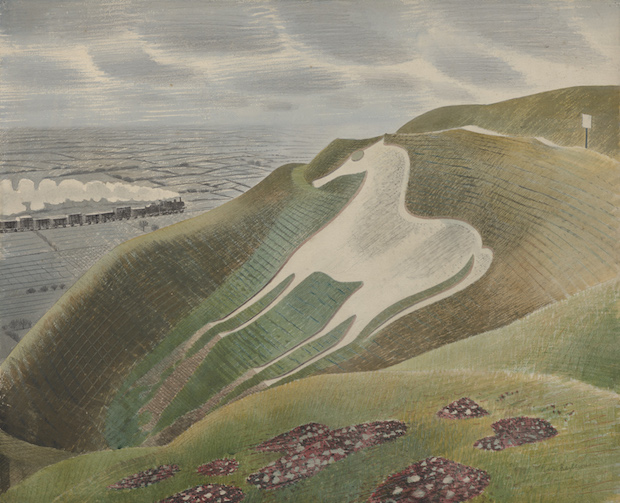
Using his dry-brush technique, Ravilious was never one to leave his paintings to chance: each brush stroke applied precisely, confidently and without the imperfections brought by adding copious water the brush. Training as a wood-engraver shines through in the way he allows the white of the paper to be exposed to varying degrees through cross-hatched lines. Ravilious’ approach to surface is one of textures and patternation, developed out of necessity when printing monotone woodblocks, and built on successfully in radiant colour. Seen most explicitly in A Farmhouse Bedroom (1930s), Ravilious’ love of pattern exposes his interest in the vernacular of the recent past – one of the hallmarks of British artists in the runup to the Festival of Britain. The juxtaposition created by this cheery, vernacular ornamentalism and the coming war is perhaps most succinctly seen in The Bedstead (1939), where the soon to be destroyed room Ravilious was staying in in Le Havre is depicted with vibrant patternation and shining whites, while an open door to the left of the painting leads to a more sombre room and a dead fireplace.
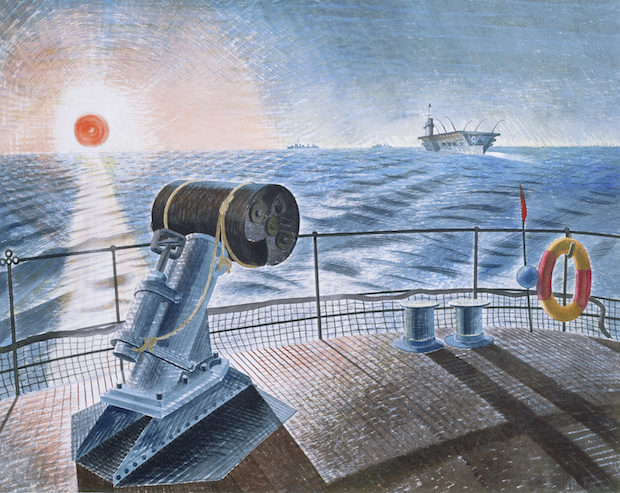
To look at Ravilious’ work is to look through the eyes of someone both solitary and almost saintly: there is always a deep empathy and compassion for humanity and nature in the work despite the persistent loneliness of the pre-war paintings. Achieved through distortions of perspective and the simple lack of figures in many of his pictures, the solitary view Ravilious presents us with must to some extent be that of the ethereal walker progressing down a winding, narrow country lane, undaunted by the persistent rain in Wet Afternoon (1938). It is the view of someone who, in the face of life’s harsh realities, refuses to restrain their wonder and joy in the world and it’s overlooked corners. It’s said that Ravilious and his great friend Edward Bawden would try to outlast each other while drawing in torrential weather on weekends spent in Essex, one refusing to go inside while the other remained.
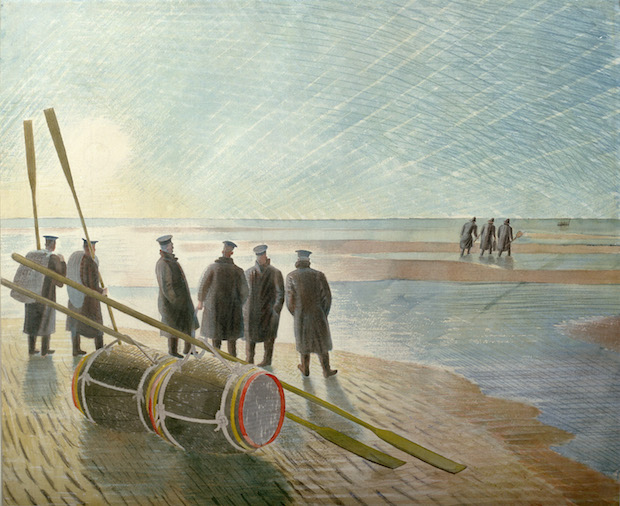
A contemporary critic talked of Ravilious’ paintings as “Something magic, almost mystic, distilled out of the ordinary everyday.” Perhaps it’s this distilled, mystical atmosphere that led to accusations that Ravilious’ war paintings were too detached, too unsympathetic. In my mind they are anything but that; the way the fighter planes dart around the sky like an ecstatic flock of birds above their nest in HMS Glorious in the Arctic (1940) doesn’t make light of, or glorify, war but shows it as a human – if not humane – endeavour. Seeing technology conquering the air and the sea, surviving in the Arctic, was exhilarating for Ravilious. Known as ‘the boy’ to his friends, through his painting’s we share in the boyish, momentary excitement the young men inside those darting planes, again seen in Hurricanes in Flight (1942), must have felt as they hurtled through the pure blue sky. We share in their innocence and that makes these war paintings all the more poignant.
Ravilious distilled a certain English type of humanity: an artistic translation of a bitter-sweet joy, a wry smile or a self-deprecating laugh.Through careful craft (particularly by never placing people in the foreground) and an almost naive fascination for everything from wallpaper to atmospherics via rusting machinery, he has imbued that humanity with a sense of something higher. People, places, warships and trains all entice Ravilious but equally they all know their place: it’s rare that anything ever outdoes nature, or more precisely, light in Ravilious’ work. This exhibition at the Dulwich Picture Gallery, and accompanying catalogue with insightful commentary on individual images, un-fussily presents Ravilious' watercolours and allows us to read again these paintings as complex art with much of originality to say on life leading up to, and during, the Second World War.
Ravilious
Until 31 August 2015
Dulwich Picture Gallery,
Gallery Road,
London,
SE21 7AD
